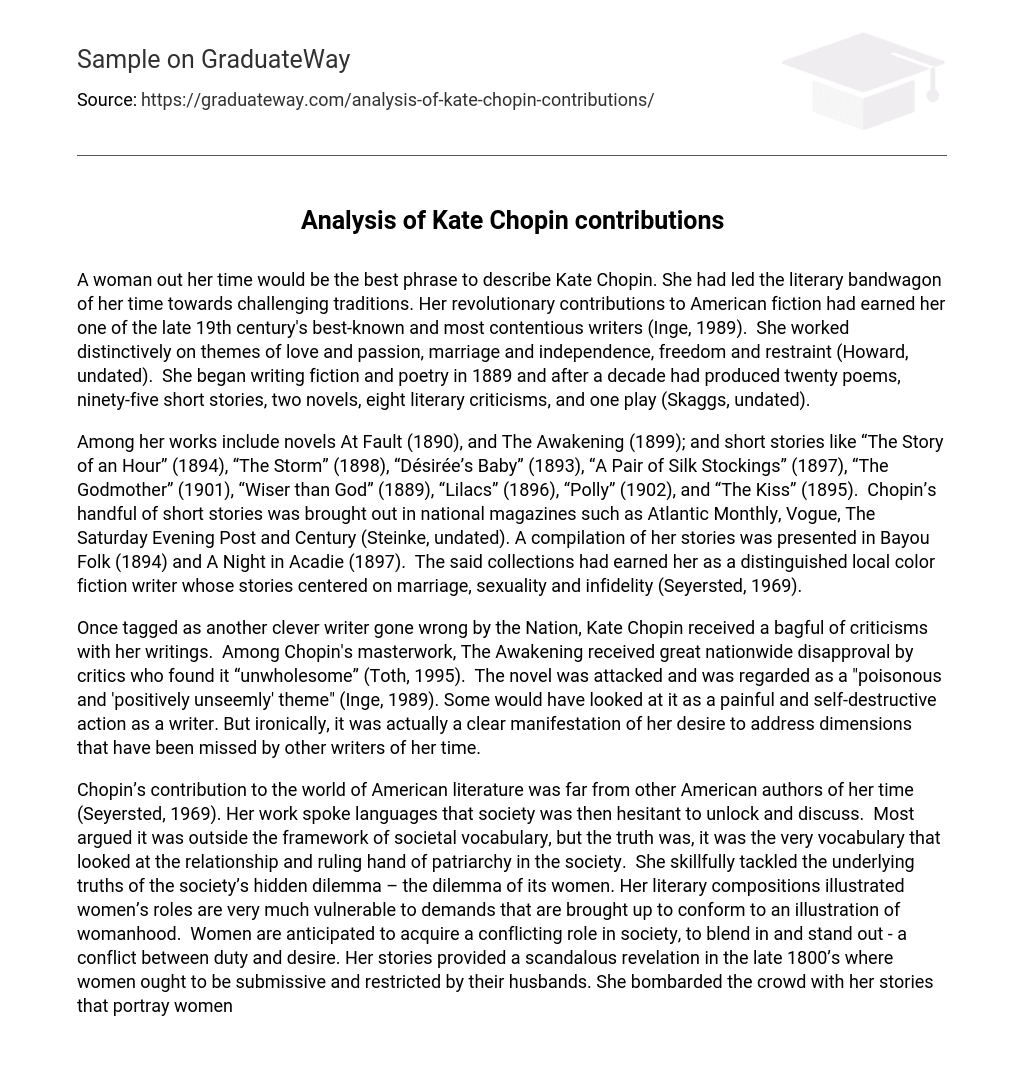A woman out her time would be the best phrase to describe Kate Chopin. She had led the literary bandwagon of her time towards challenging traditions. Her revolutionary contributions to American fiction had earned her one of the late 19th century’s best-known and most contentious writers (Inge, 1989). She worked distinctively on themes of love and passion, marriage and independence, freedom and restraint (Howard, undated). She began writing fiction and poetry in 1889 and after a decade had produced twenty poems, ninety-five short stories, two novels, eight literary criticisms, and one play (Skaggs, undated).
Among her works include novels At Fault (1890), and The Awakening (1899); and short stories like “The Story of an Hour” (1894), “The Storm” (1898), “Désirée’s Baby” (1893), “A Pair of Silk Stockings” (1897), “The Godmother” (1901), “Wiser than God” (1889), “Lilacs” (1896), “Polly” (1902), and “The Kiss” (1895). Chopin’s handful of short stories was brought out in national magazines such as Atlantic Monthly, Vogue, The Saturday Evening Post and Century (Steinke, undated). A compilation of her stories was presented in Bayou Folk (1894) and A Night in Acadie (1897). The said collections had earned her as a distinguished local color fiction writer whose stories centered on marriage, sexuality and infidelity (Seyersted, 1969).
Once tagged as another clever writer gone wrong by the Nation, Kate Chopin received a bagful of criticisms with her writings. Among Chopin’s masterwork, The Awakening received great nationwide disapproval by critics who found it “unwholesome” (Toth, 1995). The novel was attacked and was regarded as a “poisonous and ‘positively unseemly’ theme” (Inge, 1989). Some would have looked at it as a painful and self-destructive action as a writer. But ironically, it was actually a clear manifestation of her desire to address dimensions that have been missed by other writers of her time.
Chopin’s contribution to the world of American literature was far from other American authors of her time (Seyersted, 1969). Her work spoke languages that society was then hesitant to unlock and discuss. Most argued it was outside the framework of societal vocabulary, but the truth was, it was the very vocabulary that looked at the relationship and ruling hand of patriarchy in the society. She skillfully tackled the underlying truths of the society’s hidden dilemma – the dilemma of its women. Her literary compositions illustrated women’s roles are very much vulnerable to demands that are brought up to conform to an illustration of womanhood. Women are anticipated to acquire a conflicting role in society, to blend in and stand out – a conflict between duty and desire. Her stories provided a scandalous revelation in the late 1800’s where women ought to be submissive and restricted by their husbands. She bombarded the crowd with her stories that portray women who struggle to live for themselves, who desires liberation from societal norms and wishes, who lives with sentiments of personal freedom and sexuality.
Page # 2
A re-awakening with Chopin’s work marked the late 20th century for the reason that her literary creations foretold the century’s feminist themes (Inge, 1989). Such elements of romanticism, realism, naturalism, transcendentalism, and existentialism, also existed in Chopin’s works which added shape and vibrant to American literature. She worked well with setting, symbolism, imagery, and irony in her compositions to capture the damaging consequences in a society where women subordination exists. More so, the ingenuity and clarity of her works provided a fertile soil for feminist ideas to exist, be nurtured and developed. Such feminist ideas had laid out the groundbreaking of a new venture in advocating for women’s roles that are manifested nowadays in numerous consciousness raising groups, in demonstrations, political movements and mass marches. She wore clothes of rebellion to norms and traditions. She broke away from the conventional and worked her way to literary roads that are less traveled. She wrote her thoughts, sentiments and personal experiences. She wrote her life and womanhood; and she wrote the lives of women in her era. Without a doubt, her writing was noteworthy on life’s events that were seen unacceptable during her period. It was then recognized that a foretaste of realism from the past would be possible with historical fiction.
The society which is born from the womb of women marginalizes its mother. It does not have to put women on the pedestal but rather give them their due in the society. However, the marginalization of women as perpetuated by men per se remains a myth. Men may contribute to the “problem”, but not the sole, red-handed perpetuators. In fact, a number of men consider themselves feminists. Being men does not hinder them from being aware of this marginalization and initiating actions to “de-marginalize” the status of women. Such marginalization of women is brought about by the institutions that exist in the society. Institutions like the state, church, media, and education, direct women to be subordinate to men. These institutions harden the basic foundations of a patriarchal society, thereby marginalizing women. Women marginalization is a product of the society’s own apathetic tolerance and submission. And Chopin’s greatest contribution was liberating women through her craft. She opened the doors of key issues in a historical context where women had almost nothing to say with their own lives. She unlocked the inner longings of real women, whose hope, fears and sexual desires are long kept. She brought up the consciousness of women, gave them the driving force they needed to get rid of their worries and liberate themselves. She brought up the alienated sector. She dared to move out of the shell and break the shackles imposed by the society. She broke away from tradition and provided ideas and thoughts that American literature had never imagined before. And like in her masterpiece, The Awakening, Kate Chopin successfully swam far out where no one had swum before. She was a feminist, a woman indeed at the forefront of her time.





